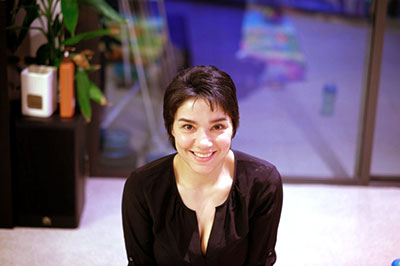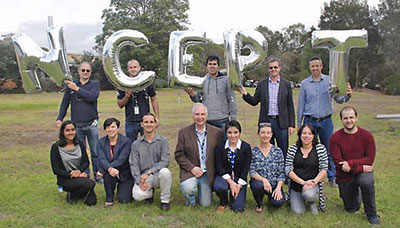Aussie technology enhances cancer radiation therapy
An Australian health researcher with the Australian Nuclear Science and Technology Organisation (ANSTO) has received a number of awards for her contribution to the development of a new hybrid technique that enhances the effectiveness of an advanced form of radiation therapy for treating cancer.
Neutron Capture Enhanced Particle Therapy (NCEPT) involves injecting a patient with a neutron capture agent shortly before irradiation with proton or heavy ion therapy. 
The approach boosts the target dose without increasing the dose to healthy tissue and delivers a significant dose to secondary lesions outside the primary treatment area.
Mitra Safavi Naeini, the imaging quantification research lead in Human Health at ANSTO, has received one of the 2018 Fraunhofer Innovation Awards from the German Embassy, which will enable her to carry out proof-of-concept experiments at German particle therapy centres later this year.
In 2017 Dr Safavi-Naeini (pictured) was selected as a recipient of the Union for International Cancer Control (UICC) and the UICC Japan National Committee Yamagiwa-Yoshida Memorial international Cancer Study Grant Fellowship. The award allows her to gain additional proof of concept evidence at the National Institute of Radiological Science in Chiba Japan.
Both Japan and Germany have leading facilities to deliver particle therapy to cancer patients, with many years of experience with the treatments.
An application to participate in the ON Prime Program this year was also successful. Dr Safavi-Naeini and colleagues from ANSTO and the University of Wollongong will take part in the program which assists researchers in accelerating concepts to market delivery.
ANSTO has acquired a provisional patent for the NCEPT method.
Particle therapy, a technologically advanced form of radiation therapy that precisely delivers energy to destroy tumours with minimal side effects, will soon be available in Australia. The first proton therapy facility is now being planned for South Australia, and ANSTO is among a group of organisations advocating for the establishment of a national heavy ion treatment and research facility. 
Dr Safavi-Naeini and PhD student Andrew Chacon of the University of Wollongong (UOW) developed the concept while estimating the quantity of thermal (low-energy) neutrons produced as a by-product of particle therapy. These neutrons are produced when the protons or heavy ions collide with tissues in the body, which sometimes result in nuclear fragmentation.
The thermal neutrons that are produced with particle therapy do not stay localised to the target volume.
“We thought that because there already are several tumour-specific drugs that can capture neutrons, we could administer them to patients prior to particle therapy,” Dr Safavi-Naeini said.
“The neutron capture process releases more energy inside the tumour, where it is beneficial, and reduces the neutron dose to healthy tissues around the treatment site.”
Simulations show that, in some tissues, current drugs can deliver a benefit of the order of 5-10 percent – however, newer drugs currently under development may offer even greater enhancement.
Preliminary experiments and simulations to date have been most encouraging, Dr Safavi-Naeini said, allowing the acquisition of a provisional patent.
Using the fellowship that will take her to Japan, Dr Safavi-Naeini will test the drug with cancer cells that are irradiated with and without the presence of neutron capture drugs and compare their survival rates against control cells.
She is also looking for other clinical centres that deliver particle therapy to build more evidence for proof-of concept.
There are a number of innovative aspects to the therapy.
The two isotopes used in the neutron capture agent are boron-10 and gadolinium-157.
“We are excited about the simulation data, which suggests that the thermal neutron dose could reach a target up to 14cm deep. This means you have the possibility of reaching deep seated tumours,” Dr Safavi-Naeini said.
“It may be beneficial to radiation resistant tumours, neuroblastomas in children, or a way of treating secondary lesions in the brain.”
Because gadolinium is also a contrast enhancement agent for imaging purposes, it also opens up the possibility of ‘vertical integration’ in treatment.
“We could go from pre-treatment through to post treatment using the same agent to guide treatment planning, monitor treatment quality and evaluate its effectiveness,” Dr Safavi-Naeini said.
ANSTO Health Research leader and professor, Marie Claude Gregoire said, “What has been achieved would not be possible anywhere else, because of the multidisciplinary team at ANSTO and the Centre for Medical Radiation Physics headed by distinguished professor Anatoly Rozenfeld of the University of Wollongong, who have considerable expertise in understanding the biological response to radiation and using it to therapeutic effect.”
Andrew Chacon, who is doing his PhD under joint supervision of Dr Safavi-Naeini, Prof. Anatoly Rozenfeld and Dr Susanna Guatelli at the Centre for Medical Radiation Physics at the University of Wollongong, is a co-inventor of NCEPT.
“Prof. Rozenfeld, with his vast experience and expertise in radiation dosimetry and microdosimetry, has given us a lot of valuable feedback in going from the physical dose to the biological dose and helped establish connections to the international network of particle therapy centres,” Dr Safavi-Naeini said.
Other contributors to the project include Prof. Marie Claude Gregoire, Dr Keith Bambery, Dr Ben Fraser, Dr Ryan Middleton, Nicholas Howell, Naomi Wyatt, Dr Tim Boyle, Attila Stopic, Dr Joseph Bevitt, Dr Ulf Garbe and Dr Justin Davis at ANSTO. Collaborators on the project from the University of Wollongong include Prof Rozenfeld and Dr Guatelli.
“When NCEPT was introduced to the neutron capture and particle therapy communities at a conference in 2018, the response from both groups was very positive,” Dr Safavi-Naeini said. “This motivated us to take the concept further.”
ends

 How to resolve AdBlock issue?
How to resolve AdBlock issue?